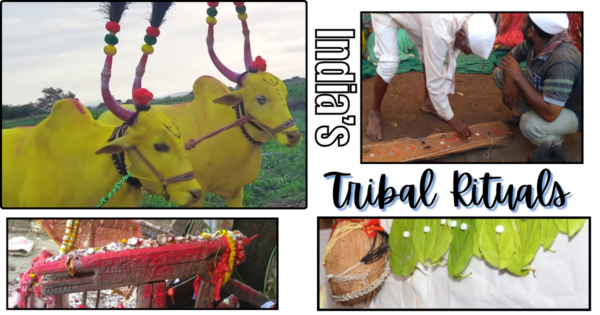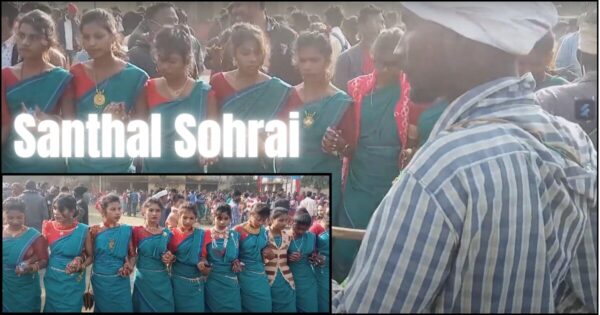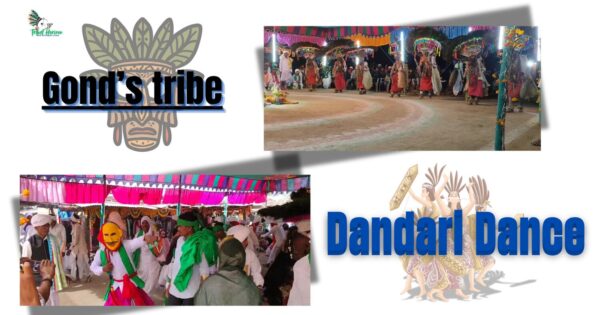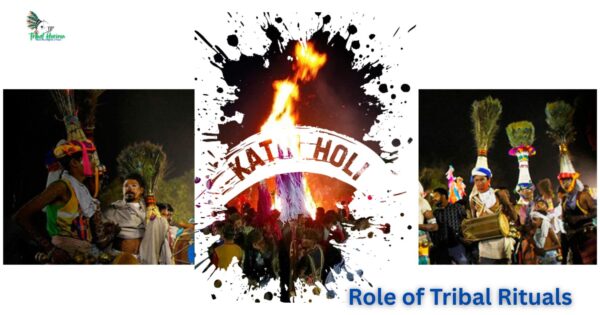The Important Role of Tribal Rituals in India

Tribal rituals, especially those linked to caste and religion, play an important role in tribal societies across India. For tribal people, these rituals are key to expressing their cultural identity and maintaining social unity. Passed down from ancestors,
tribal rituals help preserve traditions and strengthen bonds within the community, creating a strong sense of belonging. Recognising the value of these rituals is crucial, as they enhance our understanding of different cultures and contribute to our collective history.
Preserving the cultural identity of tribal
Tribal rituals serve as a vital link between today’s tribal communities and their ancestral roots. Through powerful ceremonial practices, folk songs sung in native dialects, vibrant dances, and lively seasonal festivals, these groups convey essential messages about their worldview and cultural values.
These rituals hold deep spiritual significance and act as a strong resistance against the pressures of cultural uniformity. By steadfastly preserving and practicing these traditions, tribal communities not only affirm their identity but also guard it against erosion, ensuring it thrives for generations to come. Embracing these rituals is key to valuing and sustaining our diverse human heritage.
The Role of Social Cohesion, Beliefs, and Tribal Rituals
Tribal rituals reflect the deep connection tribal have with nature, which they see as a father and thank through acts of reverence, making them known as nature worshippers.
These tribal rituals express shared beliefs and strengthen community bonds. Whether during festivals, weddings, birth and death ceremonies, sacrifices, dances, or songs, these rituals involve everyone in the community. This collective participation promotes unity and mutual support among tribal members.
These practices, rooted in tribal rituals, have been part of tribal life for generations. They are closely tied to the spirits of ancestors and the natural cycles of life and death.
Elders often say that ancestors are always with them, guiding them on the right path. Tribal rituals are essential for keeping their belief systems strong and preserving harmony within the community. Through these rituals, tribal people stay connected to nature and continue to follow its laws.
Diverse and Rich Tribal Rituals Across India
India has over 750 tribal communities spread across various states. Each community has unique customs, spiritual practices, and rituals that they pass down through generations. These rituals connect them to nature and their ancestors, and they hold great respect for life and its culture.
Some notable festivals include the Hornbill Festival in Nagaland, the Bhagoriya Festival of the Bhils in Madhya Pradesh, the Pola Festival in Maharashtra, the Baiga Agni Dances in Chhattisgarh, and the Sohrai paintings in Jharkhand. These traditions show how closely the tribes are connected to the land, animals, seasons, and spirits.
Understanding tribal rituals is important for discovering how these traditions are viewed in the world. In tribal communities, living in harmony with nature is sacred. As modern life spreads across the country, it is crucial to protect and preserve these ancient customs and traditions.
Today, we will discuss the religious rituals of major tribal communities. In the upcoming blog, we will explore each tribe’s spiritual practices in detail.
Santhal Sohrai: A Vibrant Celebration of the Harvest

The Santhal tribe is one of the largest tribal communities in India. Many tribal societies view grain as sacred, and their tribal rituals reflect a deep respect for nature and sustenance. They celebrate harvest festivals in various regions, and among these,
the Sohrai festival holds special importance. Sohrai showcases the strong connection between the Santhals, the earth, their livestock, and their ancestral spirits, blending gratitude and tradition through meaningful tribal rituals.
Gonds: Dandari Dance and Worship of Nature

The Gond tribal community is one of the largest and oldest groups in Central India. They have a rich cultural heritage that includes natural and oral traditions. The Gond tribe lives in Madhya Pradesh, Chhattisgarh, Maharashtra, Telangana, and Odisha. They are known for their animistic beliefs, tribal rituals, and lively folk art and dance.
The Dandari dance is a religious folk dance performed by tribal men who carry sticks. This dance honors nature and comes from stories told by elders. It is mostly performed during the post-harvest season as part of the Dandari Festival, which pays tribute to clan gods and ancestral spirits.
The dancers, usually men, wear traditional clothing specific to their caste, paint their bodies, and make a unique sound by hitting their sticks together. This dance shows their connection with nature. The Dandari dance also tells stories from Gond mythology and local legends, especially those about the Pandavas and their clan deities.
Nagaland: The Hornbill Festival and Head-Hunting Traditions

Nagaland is a state in the northeastern hills of India. It is known for its rich tribal heritage, tribal rituals, and traditional customs. The Naga tribes have lived here for a very long time, preserving their unique way of life. One popular event in Nagaland is the Hornbill Festival.
This festival celebrates Naga culture, tribal rituals, and unity, and it draws visitors from all over India. It is celebrated annually from December 1 to 10 at the Kisama Heritage Village near Kohima. It also highlights the tribes’ past head-hunting traditions, now an important part of their history.
Why “Hornbill”?
The festival is named after the Indian hornbill, a bird that is seen as a message from nature to the Naga tribes. It represents unity, traditions, and respect for nature.
What Was Head-Hunting?
In traditional Naga tribal society, beheading an enemy served several important purposes: –
Bhil Rituals and Festivals:Holi (Tribal Style)

The Bhil caste is one of the largest tribal communities in India. They have their own unique customs, tribal rituals, and a strong connection to nature and their community. While Holi is a popular festival across India, it is especially meaningful to the Bhil people. For them,
Holi is not just about throwing colours; it is a special time for coming together, celebrating their ancestors, and honouring their clan goddesses through tribal rituals, dance, and joy.
Holi Dahan: Purifying the village
Holi is very important in Bhil society and is seen as a sacred festival. People believe that the Holi Goddess takes away their sadness and troubles, bringing happiness for the new year. They show thanks to Holika Devi by making offerings, dancing, singing, and preparing food or a special drink for their ancestors.
They only eat the food themselves after honoring their ancestors. Unlike the celebrations in cities, the rituals of the Bhil people are based on their tribal traditions. Villagers create the Holi fire using wood, dung, and branches from sacred trees,
which they gather from their homes and the forest. The event is organised by five elders of the village, and the dancing goes on all night long. Holi is celebrated for five days in the Bhil society. The Kathi Ni Holi of Maharashtra is especially popular, and we will talk more about it in another blog.
FQA
What are the major festivals celebrated by the Bhil tribe?
The Bhils celebrate several festivals, including Bhagoriya, Holi, Diwali (the harvest festival), Pola (Chauri Amavasya), and Vaghdev. Each celebration honors nature, crops, and tribal deities, accompanied by various religious rituals.
Why is nature central to tribal rituals in India?
Indian tribes view water, forests, and land as sacred and essential to life. They honour holy spirits and ancestors, reflecting their deep connection to nature and spirituality.
Are sacrifices still a part of tribal rituals?
Many tribes, like the Bhil, Gond, and Santhal, traditionally offered chickens, goats, or grains to their gods and ancestors. However, these practices are becoming less common as people move away from them.
Do tribal rituals vary across regions?
Religious rituals in tribal communities are diverse but very common. They place great importance on nature.
How do tribal rituals connect with health and healing?
Tribal healers use herbs, chanting, and trance rituals to treat spiritual issues, black magic, and the evil eye. They also help with illnesses caused by ancestors’ displeasure.
Conclusion
The rituals of India’s tribal communities are more than just traditions; they are a special way of life. These rituals show a deep respect for nature, community, and the unseen forces of life. In today’s fast-paced world, where everyone is looking for sameness, keeping these tribal practices alive is important. By appreciating and understanding these rituals, we can find better ways to live and help future generations. Let’s listen, learn, and celebrate the unique cultural traditions of India’s tribal people.
In free to share your feedback. If you have any issues or any kind of questions, you can comment below. Thank u….

